SUZUKI GRAND VITARA 2008 3.G Inspection And Maintenance Manual
Manufacturer: SUZUKI, Model Year: 2008, Model line: GRAND VITARA, Model: SUZUKI GRAND VITARA 2008 3.GPages: 48, PDF Size: 1.33 MB
Page 11 of 48
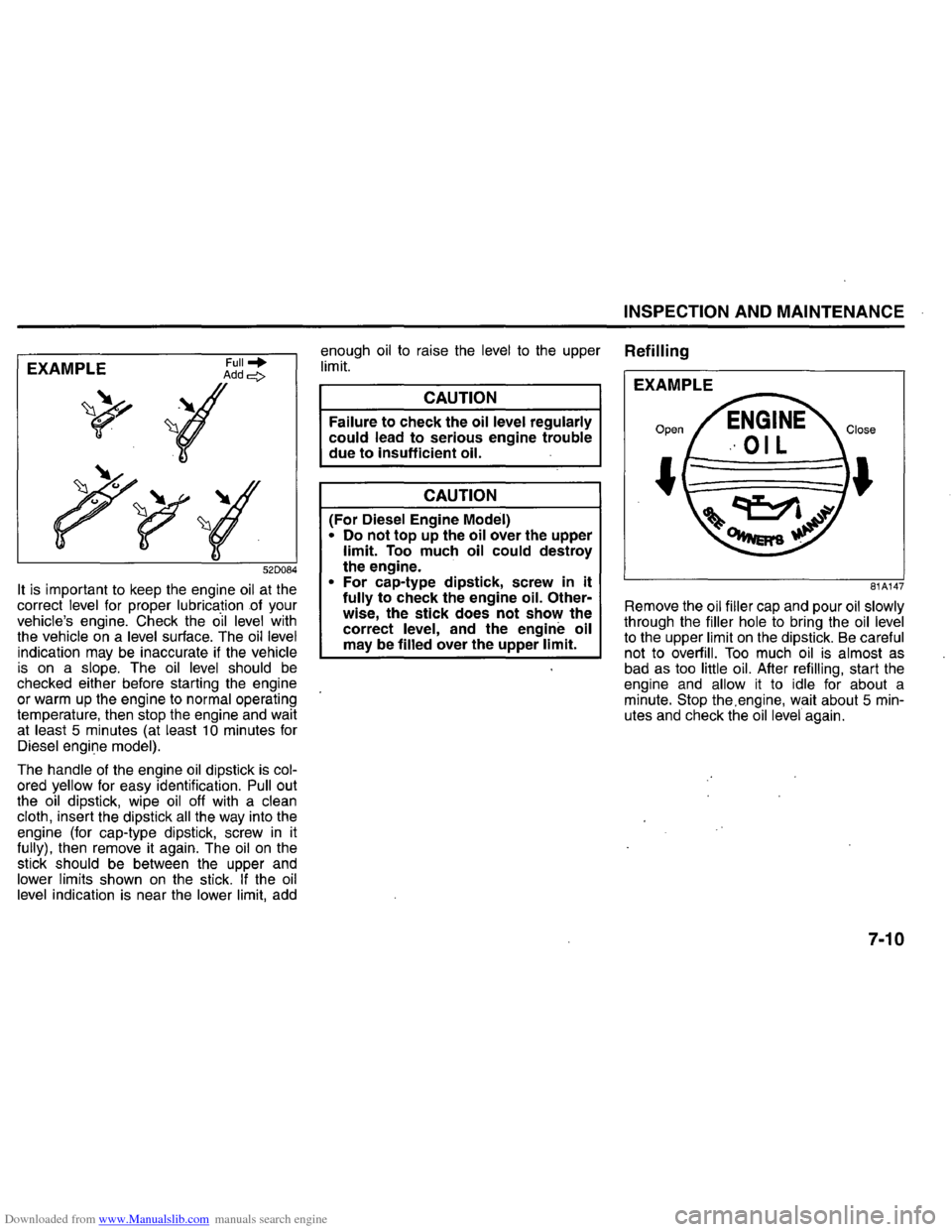
Downloaded from www.Manualslib.com manuals search engine EXAMPLE
520084
It is important to keep the engine oil at the
correct level for proper lubrica.tionof your vehicle's engine. Check the oil level with
the vehicle on a level surface. The oil level indication may be inaccurate if the vehicle is on a slope. The oil level should be checked either before starting the engine
or warm up the engine to normal operating
temperature, then stop the engine and wait
at least 5 minutes (at least 10 minutes for Diesel engine model).
The handle of the engine oil dipstick is colored yellow for easy identification. Pull out
the oil dipstick, wipe oil off with a clean cloth, insert the dipstick all the way into the
engine (for cap-type dipstick, screw in it fully), then remove it again. The oil on the
stick should be between the upper and lower limits shown on the stick. If the oil level indication is near the lower limit, add
enough oil to raise the level to the upper limit.
CAUTION
Failure to check the oil level regularly could lead to serious engine trouble due to insufficient oil.
CAUTION
(For Diesel Engine Model)
• Do not top up the oil over the upper limit. Too much oil could destroy
the engine.
• For cap-type dipstick, screw in it fully to check the engine oil. Otherwise, the stick does not show the correct level, and the engine oil
may be filled over the upper limit.
INSPECTION AND MAINTENANCE
Refilling
EXAMPLE
81A147
Remove the oil filler cap and pour oil slowly through the filler hole to bring the oil level to the upper limit on the dipstick. Be careful not to overfill. Too much oil is almost as bad as too little oil. After refilling, start the
engine and allow it to idle for about a
minute. Stop the.engine, wait about 5 minutes and check the oil level again.
7-10
Page 12 of 48
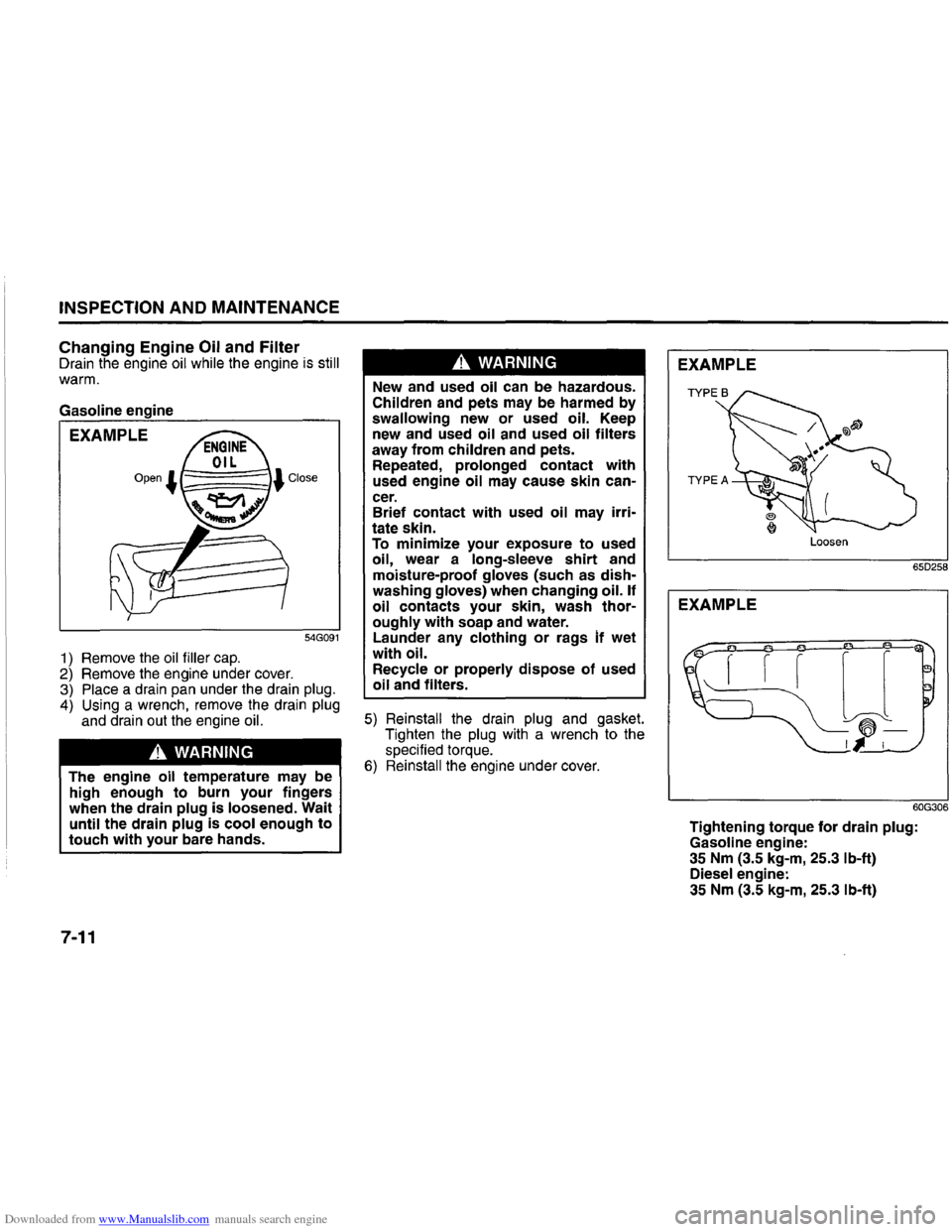
Downloaded from www.Manualslib.com manuals search engine INSPECTION AND MAINTENANCE
Changing Engine Oil and Filter Drain the engine oil while the engine is still
warm.
Gasoline engine
EXAMPLE
~~~~J' Close
54G091
1) Remove the oil filler cap. 2) Remove the engine under cover.
3) Place a drain pan under the drain plug.
4) Using a wrench, remove the drain plug
and drain out the engine oil.
A WARNING
The engine oil temperature may be
high enough to burn your fingers
when the drain plug is loosened. Wait
until the drain plug is cool enough to touch with your bare hands.
7-11
A WARNING
New and used oil can be hazardous.
Children and pets may be harmed by
swallowing new or used oil. Keep
new and used oil and used oil filters
away from children and pets.
Repeated,
prolonged contact with used engine oil may cause skin cancer.
Brief contact with used oil may irritate skin. To minimize your exposure to used
oil, wear a long-sleeve shirt and
moisture-proof gloves (such as dishwashing gloves) when changing oil. If oil contacts your skin, wash thor
oughly with soap and water.
Launder any clothing or rags if wet
with oil.
Recycle or properly dispose of used
oil and filters.
5) Reinstall the drain plug and gasket.
Tighten the plug with a wrench to the
specified torque.
6) Reinstall the engine under cover.
EXAMPLE
Loosen
65D258
EXAMPLE
60G306
Tightening torque for drain plug:
Gasoline engine:
35 Nm (3.5 kg-m, 25.3 Ib-ft)
Diesel engine: 35 Nm (3.5 kg-m, 25.3 Ib-ft)
Page 13 of 48
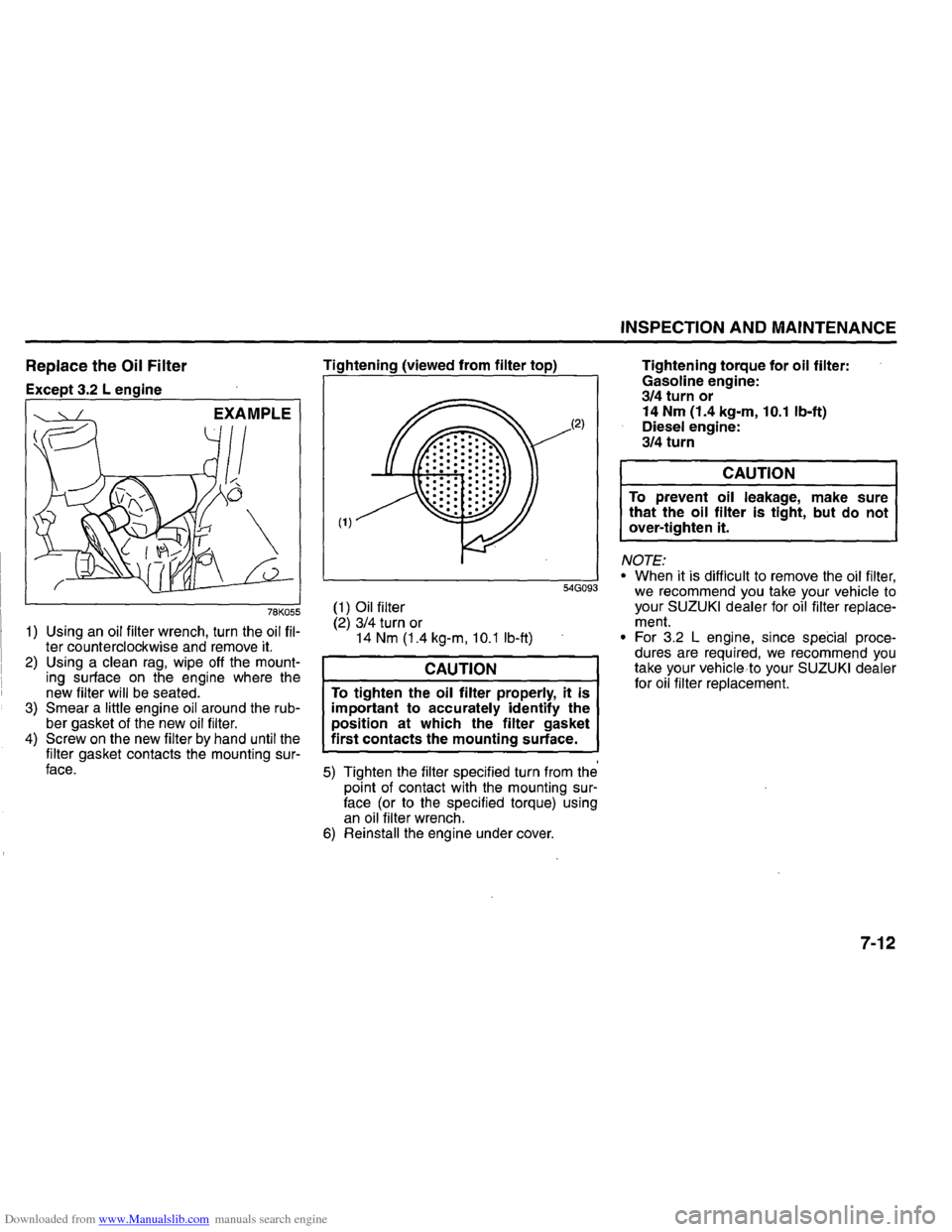
Downloaded from www.Manualslib.com manuals search engine Replace the Oil Filter
Except 3.2 L engine
EXAMPLE
~U
1:0
78K055
1) Using an oil filter wrench, turn the oil filter counterclockwise and remove it. 2) Using a clean rag, wipe off the mounting surface on the engine where the
new filter will be seated. 3) Smear a little engine oil around the rubber gasket of the new oil filter. 4) Screw on the new filter by hand until the filter gasket contacts the mounting surface.
Tightening (viewed from filter top)
(1)
(1) Oil filter (2) 3/4 turn or
14 Nm (1.4 kg-m, 10.1Ib-ft)
CAUTION
(2)
54G093
To tighten the oil filter properly, it is important to accurately identify the
position at which the filter gasket
first contacts the mounting surface.
5) Tighten the filter specified turn from the
point of contact with the mounting surface (or to the specified torque) using an oil filter wrench. 6) Reinstall the engine under cover.
INSPECTION AND MAINTENANCE
Tightening torque for oil filter: Gasoline engine: 3/4 turn or 14 Nm (1.4 kg-m, 10.1 Ib-ft)
Diesel engine: 3/4 turn
CAUTION
To prevent oil leakage, make sure
that the oil filter is tight, but do not
over-tighten it.
NOTE: • When it is difficult to remove the oil filter, we recommend you take your vehicle to your SUZUKI dealer for oil filter replacement. • For 3.2 L engine, since spedal procedures are required, we recommend you take your vehicle to your SUZUKI dealer for oil filter replacement.
7-12
Page 14 of 48
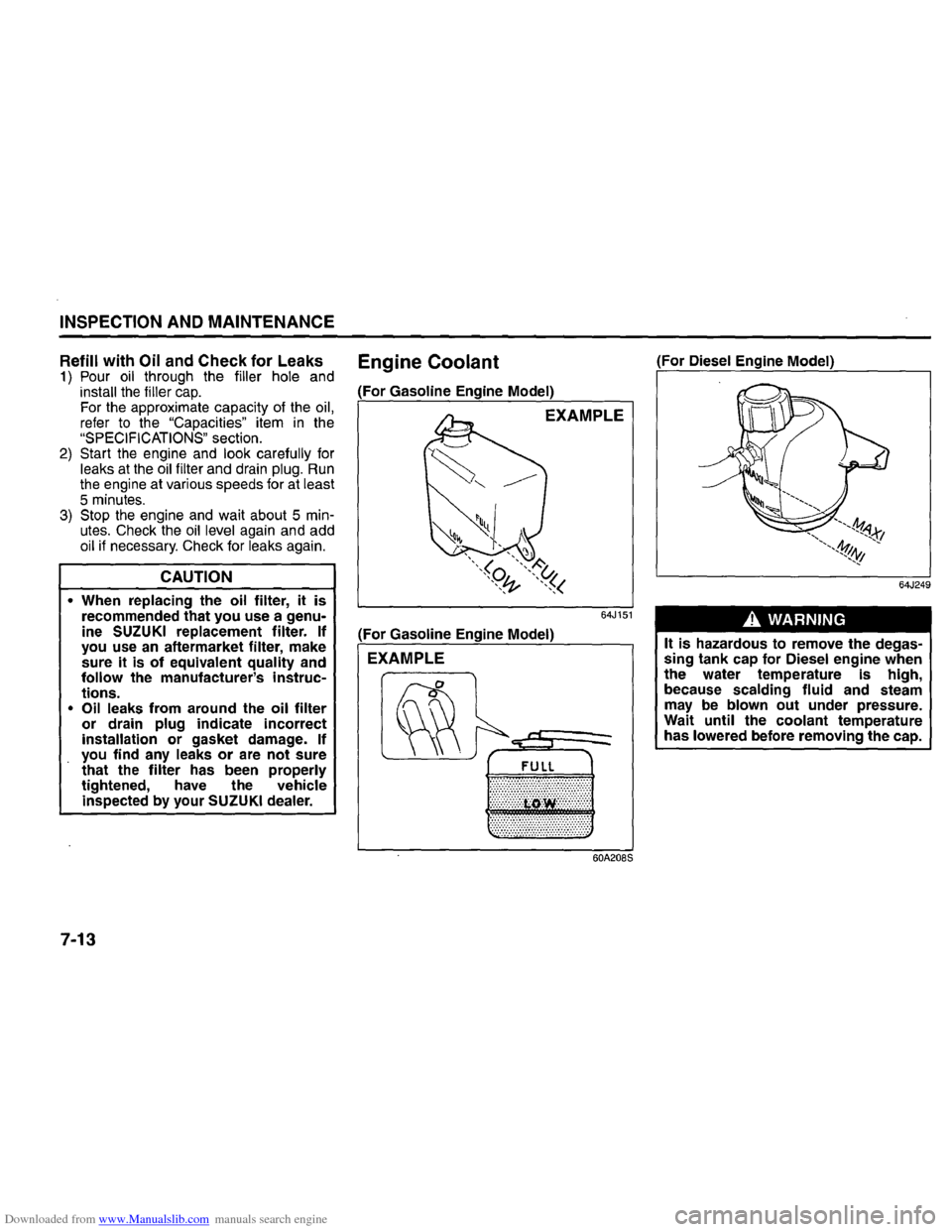
Downloaded from www.Manualslib.com manuals search engine INSPECTION AND MAINTENANCE
Refill with Oil and Check for Leaks 1) Pour oil through the filler hole and install the filler cap. For the approximate capacity of the oil, refer to the "Capacities" item in the "SPECIFICATIONS" section. 2) Start the engine and look carefully for leaks at the oil filter and drain plug. Run
the engine at various speeds for at least 5 minutes. 3) Stop the engine and wait about 5 min
utes. Check the oil level again and add oil if necessary. Check for leaks again.
CAUTION
• When replacing the oil filter, it is recommended that you use a genu
ine SUZUKI replacement filter. If you use an aftermarket filter, make
sure it is of equivalent quality and follow the manufacturer's instruc
tions.
• Oil leaks from around the oil filter or drain plug indicate incorrect installation or gasket damage. If you find any leaks or are not sure
that the filter has been properly tightened, have the vehicle inspected by your SUZUKI dealer.
7-13
Engine Coolant
(For Gasoline Engine Model)
EXAMPLE
64J151
(For Gasoline Engine Model)
EXAMPLE
(For Diesel Engine Model)
64J249
.A WARNING
It is hazardous to remove the degas
sing tank cap for Diesel engine when
the water temperature is high,
because scalding fluid and steam may be blown out under pressure.
Wait until the coolant temperature
has lowered before removing the cap.
Page 15 of 48
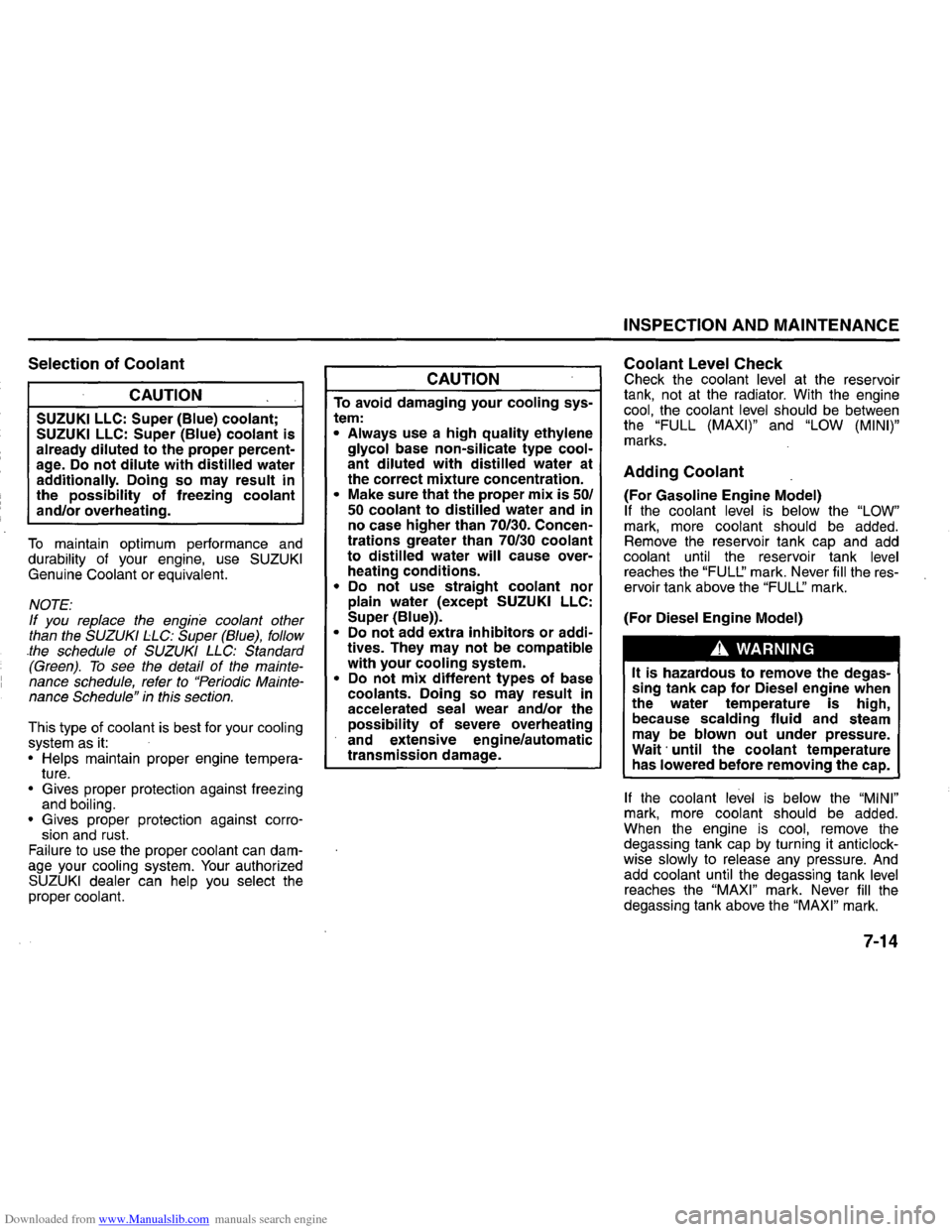
Downloaded from www.Manualslib.com manuals search engine Selection of Coolant CAUTION
SUZUKI LLC: Super (Blue) coolant;
SUZUKI LLC: Super (Blue) coolant is already diluted to the proper percent
age. Do not dilute with distilled water additionally. Doing so may result in the possibility of freezing coolant and/or overheating.
To maintain optimum performance and durability of your engine, use SUZUKI Genuine Coolant or equivalent.
NOTE: If you replace the engine coolant other
than the SUZUKIl:.LC: Super (Blue), follow
.the schedule of SUZUKI LLC: Standard
(Green). To see the detail of the maintenance schedule, refer to "Periodic Maintenance Schedule" in this section.
This type of coolant is best for your cooling system as it: • Helps maintain proper engine temperature. • Gives proper protection against freezing
and boiling.
• Gives proper protection against corro-
sion and rust. Failure to use the proper coolant can damage your cooling system. Your authorized SUZUKI dealer can help you select the
proper coolant.
CAUTION
To avoid damaging your cooling system: • Always use a high quality ethylene
glycol base non-silicate type coolant diluted with distilled water at the correct mixture concentration. • Make sure that the proper mix is 50/ 50 coolant to distilled water and in no case higher than 70/30. Concentrations greater than 70/30 coolant to distilled water will cause overheating conditions. • Do not use straight coolant nor plain water (except SUZUKI LLC: Super (Blue».
• Do not add extra inhibitors or additives. They may not be compatible with your cooling system. • Do not mix different types of base coolants. Doing so may result in accelerated seal wear and/or the possibility of severe overheating and extensive engine/automatic
transmission damage.
INSPECTION AND MAINTENANCE
Coolant Level
Check Check the coolant level at the reservoir
tank, not at the radiator. With the engine cool, the coolant level should be between
the "FULL (MAXI)" and "LOW (MINI)" marks.
Adding Coolant
(For Gasoline Engine Model) If the coolant level is below the "LOW" mark, more coolant should be added. Remove the reservoir tank cap and add coolant until the reservoir tank level reaches the "FULt..:' mark. Never fill the reservoir tank above the "FULt..:' mark.
(For
Diesel Engine Model)
A. WARNING
It is hazardous to remove the degassing tank cap for Diesel engine when the water temperature is high,
because scalding fluid and steam may be blown out under pressure. Wait· until the coolant temperature has lowered before removing the cap.
If the coolant level is below the "MINI" mark, more coolant should be added. When the engine is cool, remove the degassing tank cap by turning it antic lockwise slowly to release any pressure. And add coolant until the degassing tank level reaches the "MAXI" mark. Never fill the
degassing tank above the "MAXI" mark.
7-14
Page 16 of 48
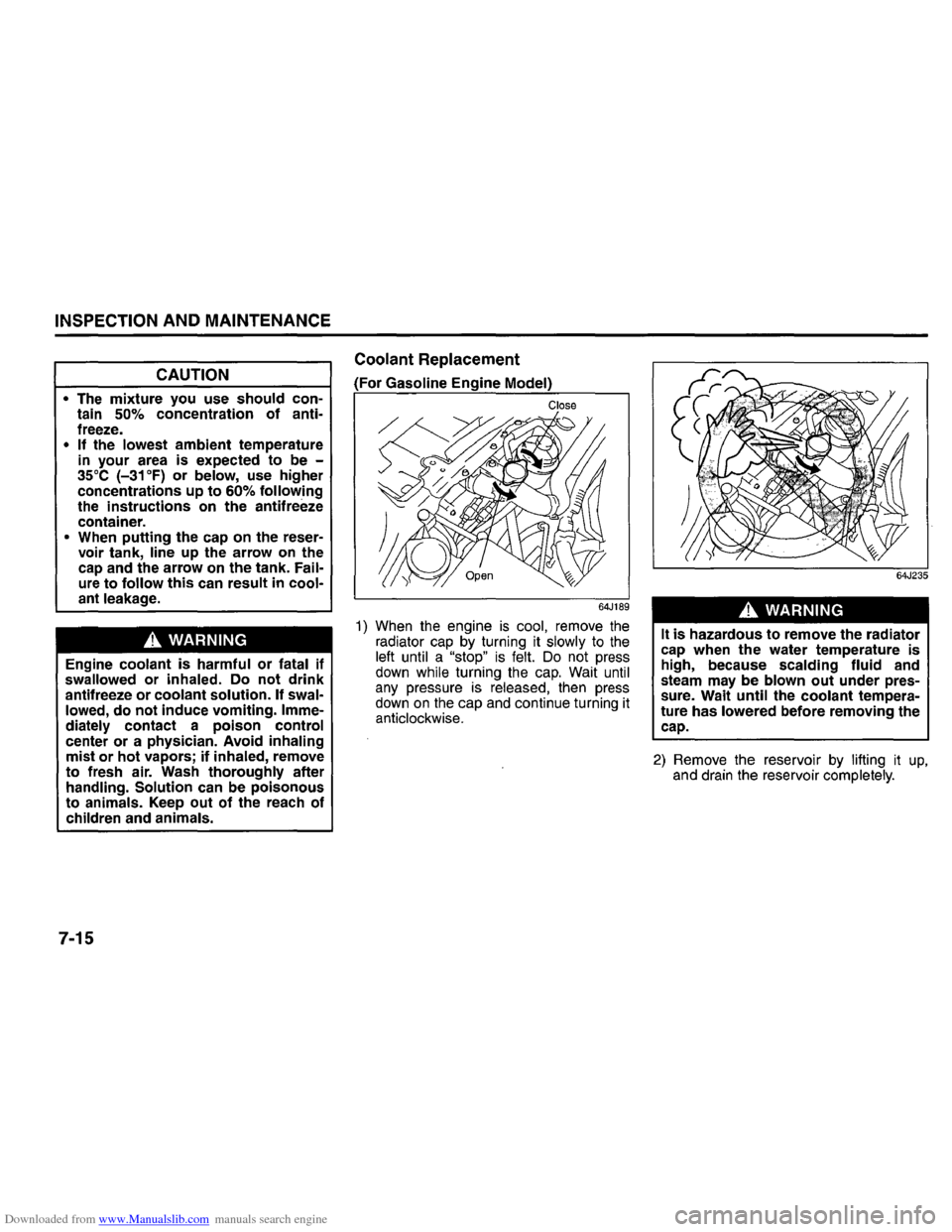
Downloaded from www.Manualslib.com manuals search engine INSPECTION AND MAINTENANCE
CAUTION
• The mixture you use should contain 50% concentration of antifreeze. • ~f the lowest ~mbient temperature In your area IS expected to be -35°C (-31°F) or below, use higher con~entrati~ns up to 60% following the instructions on the antifreeze
container.
• When putting the cap on the reservoir tank, line up the arrow on the
cap and the arrow on the tank. Failure to follow this can result in coolant leakage.
A. WARNING
Engine coolant is harmful or fatal if swallowed or inhaled. Do not drink antifreeze or coolant solution. If swalI~wed, do not induce vomiting. Imme
diately contact a poison control c~nter or a physician. Avoid inhaling mist or hot vapors; if inhaled remove to fresh air. Wash thoroughly after handling. Solution can be poisonous to animals. Keep out of the reach of children and animals.
7-15
Coolant Replacement
(For Gasoline Engine Model)
Close
64J189
1) Wh~n the engine is cool, remove the radiator cap by turning it slowly to the left until ~ "stop:' is felt. Do not press
down while turning the cap. Wait until any pressure is released, then press down on the cap and continue turning it
anticlockwise.
.A. WARNING
It is hazardous to remove the radiator c~p when the water temperature is high, because scalding fluid and
steam may be blown out under pressure. Wait until the coolant temperature has lowered before removing the
cap.
2) Redmov~ the reservoir by lifting it up, an drain the reservoir completely.
Page 17 of 48
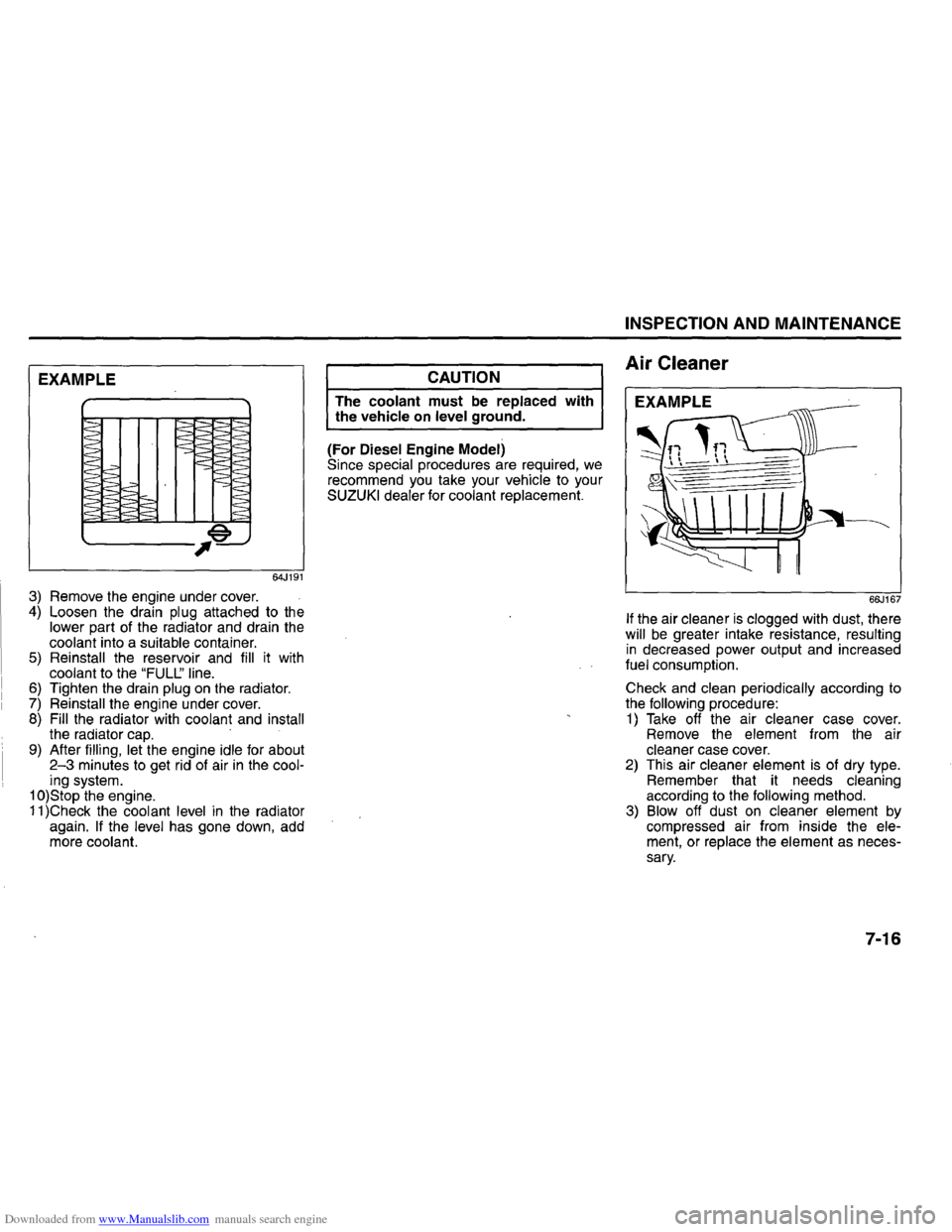
Downloaded from www.Manualslib.com manuals search engine EXAMPLE
64J191
3) Remove the engine under cover. 4) Loosen the drain plug attached to the lower part of the radiator and drain the coolant into a suitable container.
5) Reinstall the reservoir and fill it with coolant to the "FULL.:' line. 6) Tighten the drain plug on the radiator. 7) Reinstall the engine under cover. 8) Fill the radiator with coolant and install
the radiator cap. 9) After filling, let the engine idle for about 2-3 minutes to get rid of air in the cooling system.
1 O)Stop the engine. 11 )Check the coolant level in the radiator
again. If the level has gone down, add
more coolant.
CAUTION
The coolant must be replaced with
the vehicle on level ground.
(For
Diesel Engine Model) Since special procedures are required, we recommend you take your vehicle to your SUZUKI dealer for coolant replacement.
INSPECTION AND MAINTENANCE
Air Cleaner
EXAMPLE
66J167
If the air cleaner is clogged with dust, there
will be greater intake resistance, resulting in decreased power output and increased fuel consumption.
Check and
clean periodically according to
the following procedure:
1) Take off the air cleaner case cover.
Remove the element from the air cleaner case cover. 2) This air cleaner element is of dry type.
Remember that it needs cleaning
according to the following method.
3) Blow off dust on cleaner element by
compressed air from inside the element, or replace the element as necessary.
7-16
Page 18 of 48
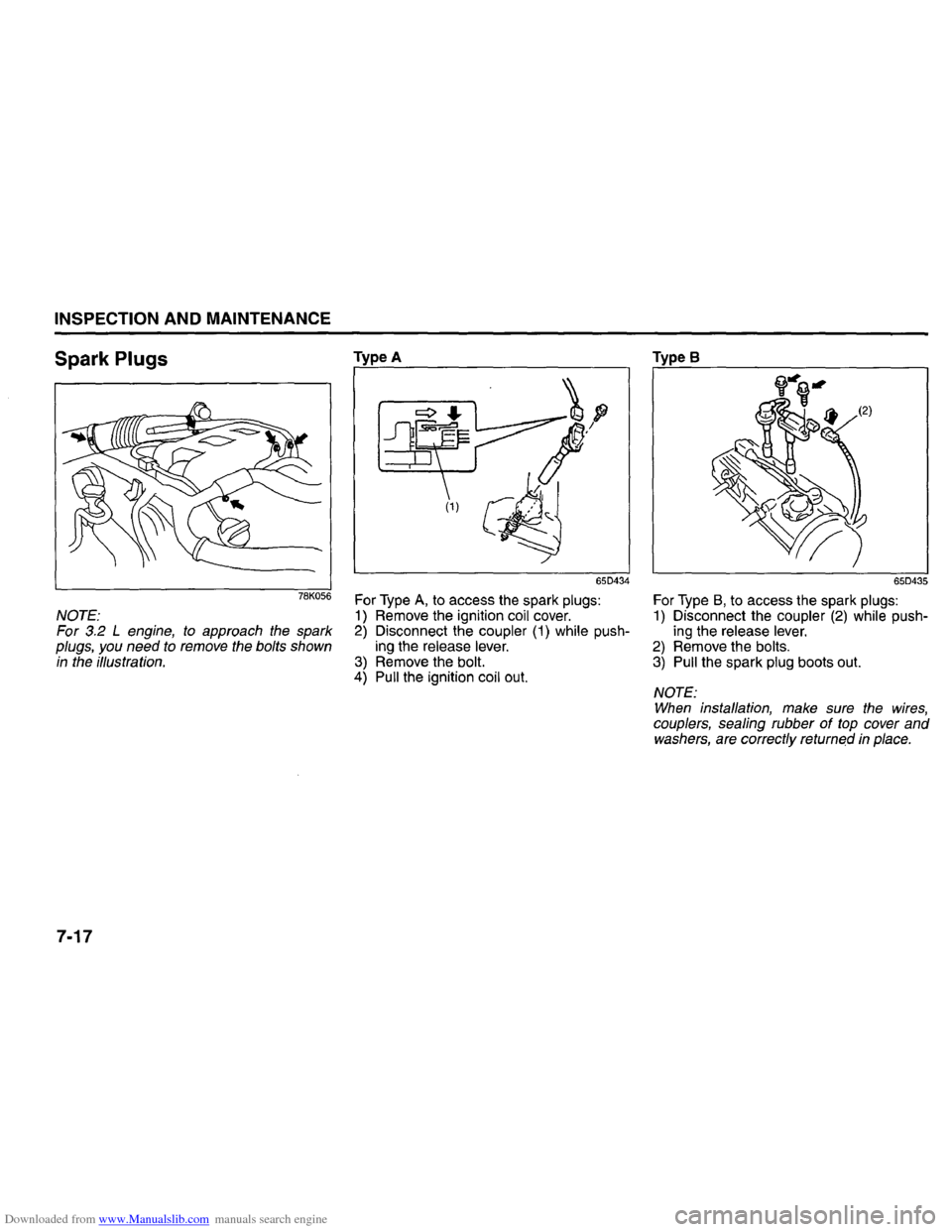
Downloaded from www.Manualslib.com manuals search engine INSPECTION AND MAINTENANCE
Spark Plugs
78K056
NOTE: For 3.2 L engine, to approach the spark
plugs, you need to remove the bolts shown in the illustration.
7-17
Type A
(1 )
65D434
For Type A, to access the spark plugs: 1) Remove the ignition coil cover. 2) Disconnect the coupler (1) while push
ing the release lever. 3) Remove the bolt. 4) Pull the ignition coil out.
Type B
(2)
65D435
For Type B, to access the spark plugs: 1) Disconnect the coupler (2) while push-
ing the release lever. 2) Remove the bolts. 3) Pull the spark plug boots out.
NOTE: When installation, make sure the wires, couplers, sealing rubber of top cover and
washers, are correctly returned in place.
Page 19 of 48
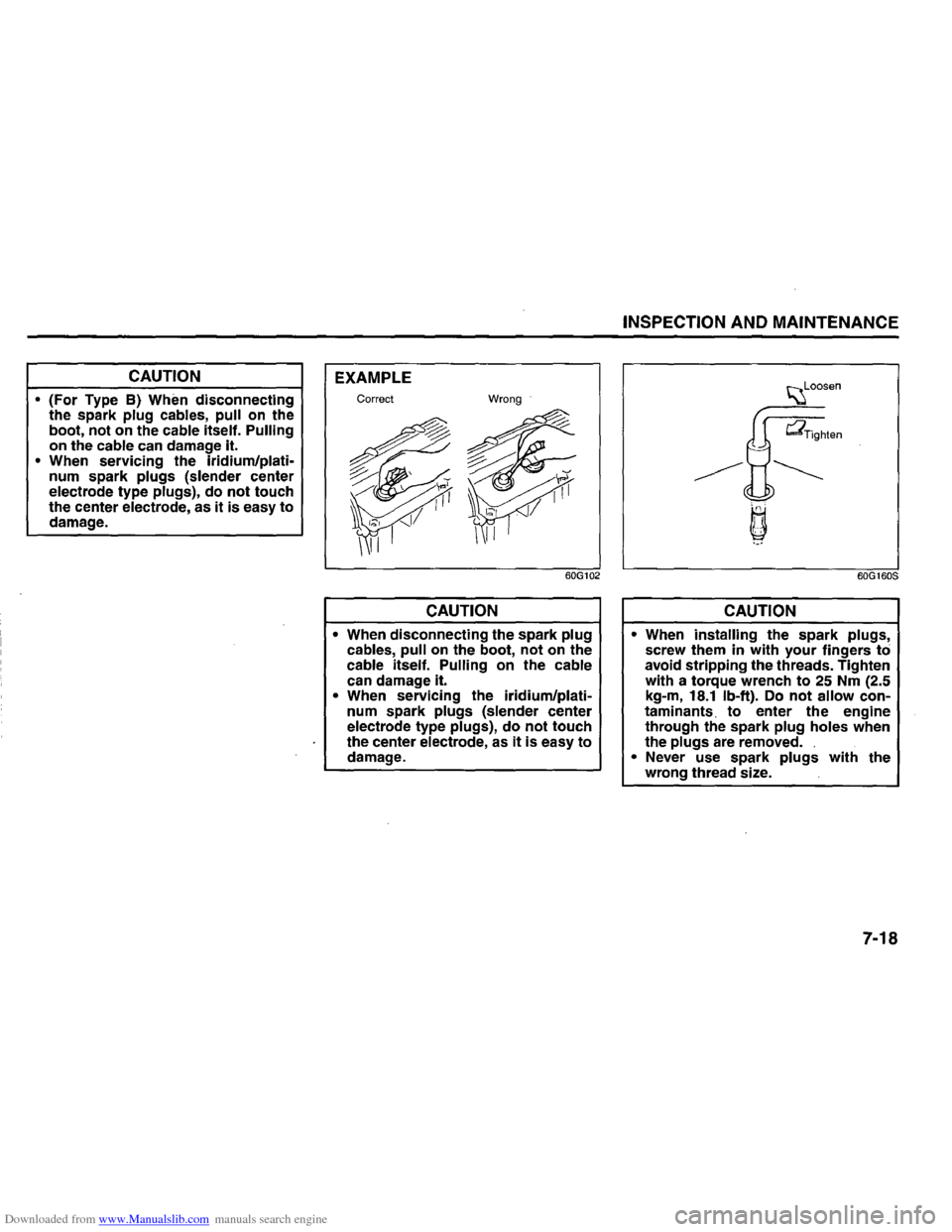
Downloaded from www.Manualslib.com manuals search engine CAUTION
• (For Type B) Whim disconnecting the spark plug cables, pull on the
boot, not on the cable itself. Pulling on the cable can damage it. • When servicing the iridium/platinum spark plugs (slender center electrode type plugs), do not touch
the center electrode, as it is easy to damage.
EXAMPLE
Correct
60G102
CAUTION
• When disconnecting the spark plug cables, pull on the boot, not on the cable itself. Pulling on the cable can damage it. • When servicing the iridium/platinum spark plugs (slender center electrode type plugs), do not touch the center electrode, as it is easy to damage.
INSPECTION AND MAINTENANCE
~Loosen
~g~"'"
ifrl
~
CAUTION
60G160S
• When installing the spark plugs, screw them in with your fingers to avoid stripping the threads. Tighten
with a torque wrench to 25 Nm (2.5
kg-m, 18.1 Ib-ft). Do not allow contaminants. to enter the engine
through the spark plug holes when
the plugs are removed. . • Never use spark plugs with the
wrong thread size.
7-18
Page 20 of 48
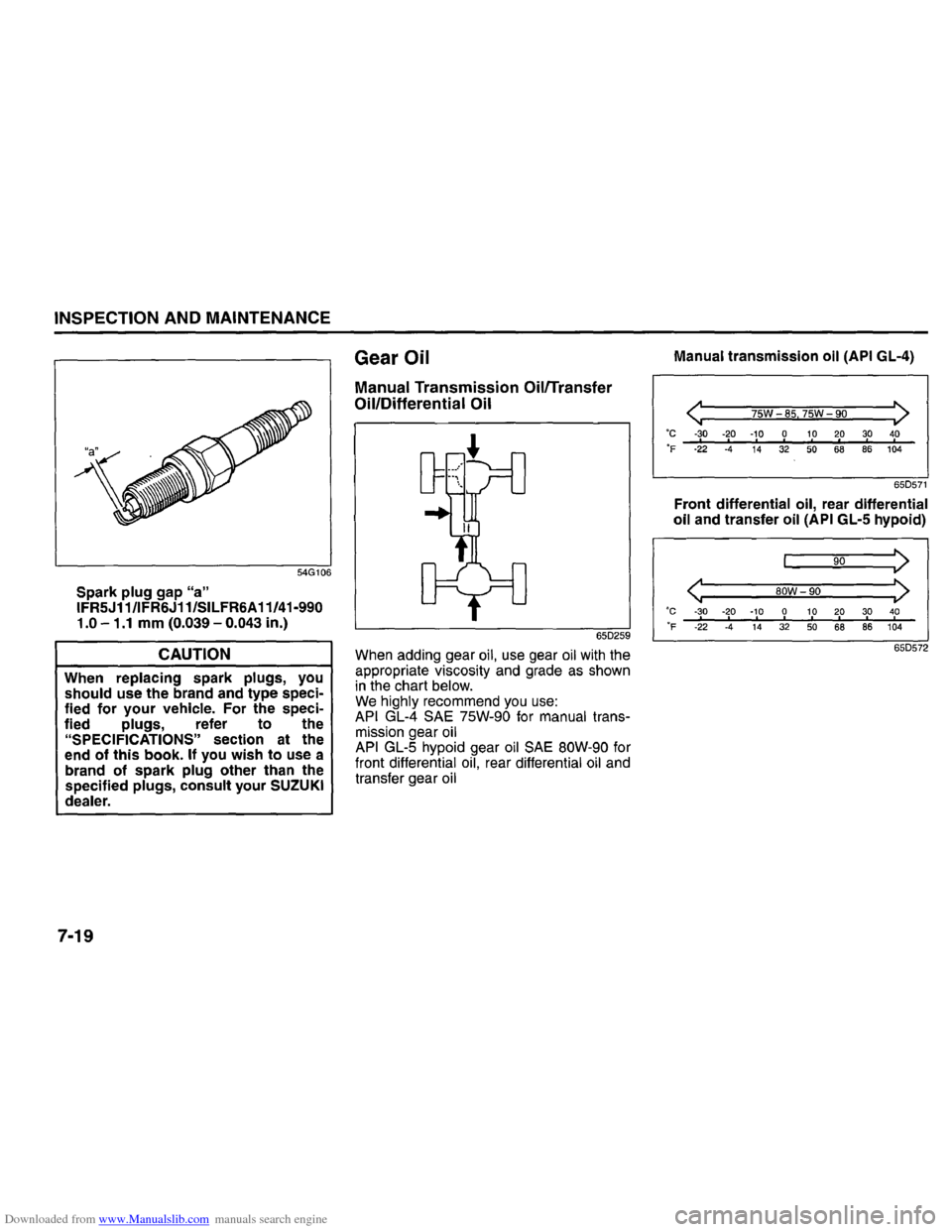
Downloaded from www.Manualslib.com manuals search engine INSPECTION AND MAINTENANCE
Spark plug gap "a" IFR5J11/1FR6J11/SILFR6A11/41-990 1.0 -1.1 mm (0.039 -0.043 in.)
CAUTION
When replacing spark plugs, you should use the brand and type specified for your vehicle. For the specified plugs, refer to the "SPECIFICATIONS" section at the
end of this book. If you wish to use a
brand of spark plug other than the
specified plugs, consult your SUZUKI
dealer.
7-19
Gear Oil
Manual Transmission OillTransfer
Oil/Differential Oil
650259
When adding gear oil, use gear oil with the
appropriate viscosity and grade as shown
in the chart below. We highly recommend you use: API GL-4 SAE 75W-90 for manual transmission gear oil API GL-5 hypoid gear oil SAE 80W-90 for
front differential oil, rear differential oil and
transfer gear oil
Manual transmission oil (API GL-4)
< 75W-85,75W 90 > °C -30 -20 -10
0 10 20 30 40 I I I I . . I I of -22 -4
14 32 50 68 86 104
650571
Front differential oil,
rear differential oil and transfer oil (API GL-5 hypoid)
90 >
< 80W
90 > °C -30 -20 -10 0
10 20 30 40 I
I I I
I I I
I 'F -22 -4
14 32 50 68 86 104
650572